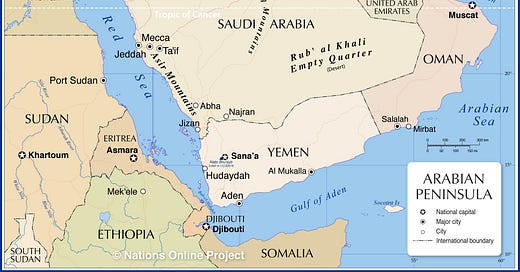When I talk to people at popups or elsewhere, most tell me that Tanoor is their first encounter with Yemeni cookery. Then I’ll spend the next few minutes or so trying to define both what it means as I see it and what it means in relation to my cooking. I’m gonna succinctly explain it here.
Historical foreground.
Technically speaking, “Yemen” in its present day1 singular form (as a country) has only been around the last few decades or so. HOWEVER "al Yaman” as both a cultural and geographical term broadly used to connote the southernmost ends of the Arabian Peninsula (including parts of modern day Oman and Saudi) has been used for millennia, even before the Arabic of today became the majority language of the region. The term originates from an older Semitic root used to refer to the directional south.
Nationstate Yemen as we know it came to be following the breakdown of the Ottoman and British empires. The Ottomans (on & off more or less) controlled much of, but never quite the entire, North from the 1500s until their collapse around WW1. In the early 1800s, Britain consolidated control over a cluster of sultanates spanning the South and maintained power until their overthrow in the late 1960s. North and South remained two separate states until their unification in 1990.
Now the food culture.
Let me first pontificate that the food most North Americans might understand as Arab food (hummus, falafel, dolma), is more specifically that of the Eastern Mediterranean communities. Folks from Palestine, Lebanon, & Syria; a region known in Arabic as al sham (aka the Levant) have been migrating here much longer than the Yemenis. They brought with them (and established restaurants whose menus consisted of) the delightful repertoire of herbaceous, verdant, and zesty flavors that their temperate homelands abundantly supported.
Yemeni food is different.
The most prominent imprints on the Yemeni foodstory came from its place in the Indian Ocean trade connecting the Arabian coast with that of East Africa, Southeast Asia, and of course, the Indian subcontinent.
The more recent century or so under the British Raj (in the South of the country) also saw an acceleration of these more South Asian influences as thousands from British India resettled along the Arabian coast.
Tea is brewed strong in the South, with milk and spices. They consume much more in the way of chiles & tamarind. Even the vernacular favors Hindi or Somali food terms.
Northern habits resemble a much more Bedouin or pastoral Arab diet; heavy with the wheat/grains, animal protein (often lamb) and dairy (often buttermilk or yogurt) and more conservatively employing earthier aromatics to season, generally forgoing the hot capsicums enjoyed by their Southerly counterparts.
Turkish influences can be found here also. The first item to mind being things like Burek- but most emblematically; Salta, a stew made with whatever you have on hand; typically eggs, vegetables, and/or animal protein. It originated in Ottoman times as a thrifty means of feeding masses in times of scarcity. The word itself is Turkish in origin.
My family’s two sides happen to be respectively from the Northern and Southern parts of the country.
I think I’ve managed to TLDR the main regional distinctions at play within Yemeni cuisine.
Tanoor is an exploration of this food as I know it, embracing a way of cooking that’s sincere to that knowledge. Some dishes are canonical, some interpretive. Though I’m at a point where I don’t see much a difference between the two. Everything that makes a final menu is the product of my own experiences, my own upbringing, my travels, my obsessive research on the region’s historic and contemporary gastronomy- as well as diasporic adaptations and things I’ve learned in community both online and locally.
-ali
Present situation needs a whole other post.




